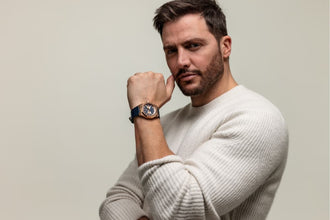

Watches are a great accessory, and the right watch can be a valuable heirloom that you can pass down through your family.
There are countless different types of watches that offer different things - for example, some watches need winding up, whereas others may use solar energy.
Some watches are water-resistant, and some watches can double as a stopwatch.
However, it can be difficult to know what to look for if you’ve never purchased a watch before, or if you don’t know much about watches.
If this is the case, don’t worry - we’ve got you covered. Keep reading for our guide to choosing your first watch.
Price
Watches can vary in price - you can find watches that cost less than £5, and watches that cost thousands and thousands of pounds.
This is why you should assess your budget before you splash out on a new watch, or even start looking for watches.
You could compare buying a watch to buying a car. First of all, set your budget - and then take some time to assess your favourite designs and features that fall within your desired price range.
Watches involve complicated mechanics that feature different designs which can make the price vary.
However, if you’re not familiar with the mechanics of a watch, then keep reading to learn more about watch movements.
Many people will choose a watch purely based on appearance - after all, watches can make a great accessory to any outfit.
You can find watches made of different materials and finishes - silver watches, sterling silver watches, and even gold watches.
Stainless steel is typically the most affordable - and the most common watch material.
Stainless steel is both durable and cost-effective, so if you’re on a low budget, then you’re best off choosing a stainless steel watch.
Different brands will sell their watches at different prices. For example, Rolex watches always cost over £1,000 - but at Amavi Watches, we pride ourselves on being an affordable watch brand and our watches can cost anything from £109 to £169 for a luxury watch.
Watch Movements
A watch is nothing without the movements - the way a watch moves is ultimately the powerhouse behind any watch.
Watchmakers pour their time and energy on the interior of a watch to create a mechanism that makes the watch function. But what exactly makes a watch tick?
Automatic
Automatic watches work around a mainspring. The automatic system is clever as it uses the movements of the wearer to boost the energy, meaning that it doesn’t need winding up.
This essentially means that you’re what’s running the watch! Your movement moves the hands of the watch. You’ll find that automatic watches may cost a little more than regular quartz watches, but are worth it for their brilliant craftsmanship.
Mechanical
Mechanical watches use the traditional system, with each component working around a mainspring. This type of timepiece may seem old fashioned, and many antique watches feature this watch movement.
In order for mechanical watches to function, you need to wind the hand daily. As new movements became more popular, mechanical watches became a thing of the past - however, they’ve become slightly more popular in recent times.
Solar
Solar watches are great as they can be powered using both artificial and natural sunlight, and you don’t need to wind them up.
The battery recharges throughout the day and can use artificial lighting to charge at night time too, meaning you’ll never run out of charge. Solar power is popular in modern times as it’s environmentally friendly.
Kinetic
Kinetic watches are similar to automatic watches - they’re powered simply by the flick of a wrist.
Wrist movements are converted into electrical power, which is then stored into the battery which essentially self-charges whenever it moves.
You don’t need to excessively move your wrist to charge your watch, as natural movements that you’d make anyway will be enough to power the watch.
Quartz
Quartz watches are powered by a battery that you may need to change every couple of years.
Watches with quartz movements are typically accurate and pretty low maintenance - you don’t need to wind them up either, which is always a bonus.
Most ‘fashion’ watches feature quartz movements, and they’re typically more affordable than other types of watch.
Extra Features
Watches can do more than just tell the time. Did you know that you can find a watch that can help you calculate speed, forecast the weather, or even work out the altitude?
You can also find watches that can feature as a stopwatch, and watches with waterproof features that are ideal for outdoor activities.
Before purchasing a watch, consider which features you’d like your ideal watch to have. If you’re sporty or outdoorsy, then you may want a watch that has some of the following features:
Tachymeter
If you’re a fan of running, cycling, or sailing, or other physical activities, then you may benefit from a watch with a tachymeter. A tachymeter can help you to calculate speed, making it useful for sports and outdoor activities.
Chronograph/ Stopwatch
A chronograph can not only keep the time but double as a stopwatch. This watch design features a second hand that can fly back, which allows it to reset at zero to start counting the time again.
Chronographs are ideal for sports and outdoor activities, and allow you to keep track of your times when running, rowing, or conducting any activity.
Barometer
If you spend lots of time outdoors, then you might want to purchase a watch with a barometer. Barometers can forecast the weather by measuring the pressure in the atmosphere, giving you an insight as to how the weather will change.
Altimeter
An altimeter is similar to a barometer but can let you know the altitude you’re at. This is perfect if you’re a climber, adventurer, or skier.
Water Resistance
Some watches feature levels of water resistance - which is ideal if you spend time outdoors.
There are different levels of water resistance - a watch that has a resistance of 30metres will stay protected in the rain, but won’t last long when submerged underwater.
However, a watch with a resistance of 50 metres will allow you to swim underwater, but you won’t be able to very deep.
If you’re a diver or snorkeler, then you’re best off choosing a watch with over 100 metres of water resistance - the deeper you plan on going, the more water resistance your watch will need.







